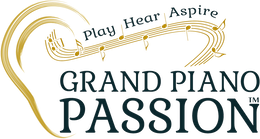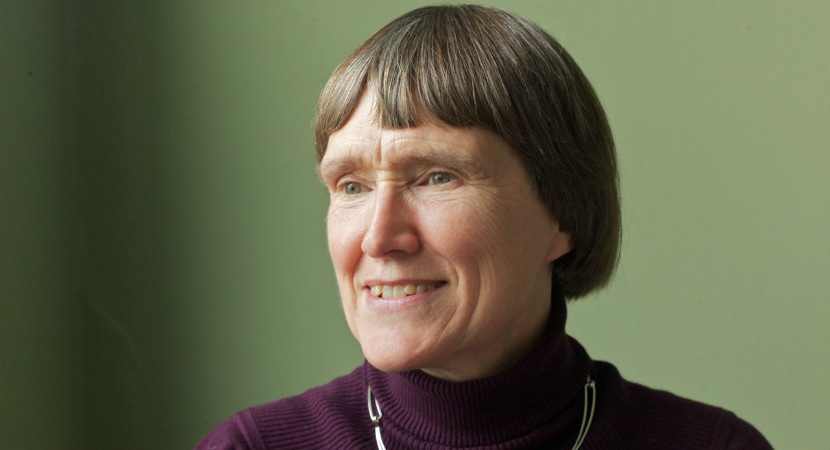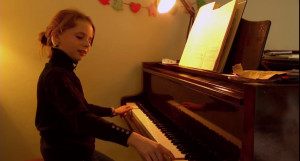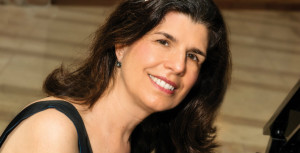As I start my car in the morning to drive to work, I hear in my head the opening measures of the Prelude of the Bach D minor cello suite.
Pushing the waiting CD into its slot, I hear those measures in the same key that played in my mind. After some 12 measures, however, I lose the melody; I hear dynamics, I hear vibrato and the sound of the bow sliding over the strings, I sense some rise and fall in pitch, but I no longer hear the key of D minor.
As I drive on, and Rostropovich plays through the suite, I hear a few more phrases clearly, but for the most part what is accessible to me is the genius of Bach, the subtlety of the phrasing, the energy of the cellist, the vigor of the interpretation—everything but the music.
My drive to work is almost exactly the length of the suite in D minor, and as an experiment I once listened to it every morning and evening for a month, striving to see if repeated experience would give me access to more of the music that I knew was there.
It did not. I heard exactly what I could remember—the parts I could whistle, the snatches that went through my head during the day. But of the passages in which Bach’s modulations made polyphony of a single melodic line, I heard no more on day 30 than I had on day one.
The miracle, of course, is that I can hear any of it. While for the first 30 years of my life I was a proficient amateur musician, over the next 25 years sensorineural hearing loss deprived me first of the violin and viola, then of the piano and guitar, then of human speech.
Deafness eventually became total; when in 2003 I decided to have a cochlear implant (CI), I had heard no recognizable sound for 10 years.
* * * *
The surgeon and the audiologist both warned me not to expect miracles from the CI, for it could not replace the 100,000 hair cells in the cochlea that permit most people to hear.
Instead, the operation would implant 16 electrodes, which, when connected to a tiny computer worn behind the ear, would send electrical impulses to the brain. Gradually, the brain would learn to recognize and interpret those impulses as sound—a process dependent on an auditory memory that my 10 years of deafness had probably caused me to lose.
As it materialized, my auditory memory had survived my years of silence. Perhaps because that memory had been stimulated by the phantom speech I had “heard” while lip-reading and the verbal agility required by my job as teacher and writer, I was one of the fortunate CI recipients who could understand speech from the day the processor was switched on.
But in the days and years after the initial euphoria, I learned that the connection between hearing and memory was simultaneously miraculous and inexplicable.
To a certain extent, my auditory memory was open to training. In the first months after the implant, my husband and I did a daily drill of one-syllable words, which initially I could not tell apart. Reef and wreath. Thumb and fun. Fir and firm.
There were dozens of them, their sounds generally of interest only to linguists, audiologists, and the programmers of voice-activated computers. In my case, they served the double purpose of teaching me to distinguish between phonemes I had not heard for years and teaching me to listen—as opposed to relying on the “hearing” strategies I had developed over the past quarter century. No context, no facial or manual cues, no lipreading. I had to hear, and I had to develop confidence in what I had heard.
* * * *
Initially, that confidence seemed to be an integral part of relearning to hear, because in the early weeks with the implant my auditory memory performed amazing feats without any effort on my part.
Two or three days after my processor was switched on, I walked down the road to a stream that rushed down a hill and flowed through a culvert at my feet. Looking at it, I heard a series of computer noises, beeps and pops that were clearly connected to the sound of the stream.
I walked home in some disappointment, consoling myself that at least I had heard something. Three days later, I walked to the same stream—and I heard the eager mutter of water tumbling downhill over stones.
The sound was unmistakable, and try as I might I could not conjure up the computer sounds that I had heard before. Sometime between Monday and Thursday, my auditory memory had taught my brain what to hear when I crossed a stream.
Emboldened by my experiences with the stream and my increasing proficiency in distinguishing phonemes, I turned to music. I had been warned that the technology was simply not up to processing the nuances of musical sound, and yet my improvement in other areas had been so marked that I hoped that determination and repetition, combined with an auditory memory conditioned by years of ear training, would give me something back.
I was not entirely wrong.
After several weeks of practice with a tuning fork, I could sing the A440 that pulsed beneath my hand. Given a guitar tuner, I could sing in tune with the instrument. Given a piano, I could play the charming, simple pieces that Bartók, Stravinsky, Kabalevsky, and Bach had written for beginning players.
Simplicity, however, was essential. The first time I heard an organ, I turned in sudden fear that a truck had driven into the church. The first time I heard a piano quartet, I couldn’t tell the sound of a violin or cello from the piano. I couldn’t tell on a CD or on the radio whether large music was orchestral or choral.
Gradually, I learned that the impossibility of understanding polyphony was part of a larger technological problem: the processor attached to my 16 electrodes processed everything it “heard,” without the 100,000 hair cells’ ability to distinguish important from unimportant sounds.
The difficulty was familiar to me; during the years I had worn a hearing aid, the clink of knives and forks at a dinner party had come to me with the same intensity as conversation, and the click of secretarial typing in offices had interfered with my ability to process speech.
* * * *
Confronted with an interpretive device that feeds it a welter of unselected information, the brain does its best, but no amount of auditory memory can distinguish meaning from the extra noises supplied by radio static, a room that echoes, side conversations, or the complexity of a symphony orchestra. The aesthetic quality of the interfering noises makes no difference; what the brain perceives is distortion.
If this were all, it would be easily understandable in the terms supplied to me by the experts: the technology, however miraculous, is not yet capable of performing musical discrimination. I would add to that, not fast enough, because I am repeatedly aware of the half or whole second it takes me to process a short spoken sentence; both the processor and the brain need to sort through thousands of possible electronic impulses, and the result is inevitably delayed understanding.
With music, the number of electronic impulses increases geometrically, and neither the processor nor the brain can sort through the possibilities quickly enough for understanding to occur. And yet, there are those opening measures of the D minor cello suite, or those moments of melody in the later gigue that suddenly appear with complete clarity from the muddle of bowing, vibrato, dynamics, and rhythm that the brain has been able to recognize but not to process.
Day after day, week after week. The same passages. The same moment of hearing. The same disappearance.
* * * *
Initially, I thought of those brief moments as “real” hearing. Now, in my fifth year of wearing a processor—the latest, upgraded version—I no longer know what “real” hearing is.
Certainly, my practice with phonemes enables me to look as if I have real hearing; as tested in the perfectly silent room of the audiologist’s office, my verbal comprehension of single words out of context hovers around 90 percent.
Yet, suppose I sit down to play the Chopin Prelude in D-flat Major on the piano—a piece my fingers recognize instantly. I play the opening bars. I hear it. I am sure. But then my fingers lose their place—and I can’t correct them, because I can apparently “hear” only what is right, not what has gone wrong.
Or suppose that, frustrated by the obvious problems that attend playing without practicing, I turn to the far-easier Bach Prelude in C Major. I play. I delight in Bach’s hymn to the tempered scale — but I suddenly realize that I am hearing it in D-flat, not in C. Playing one of the chords again and again will eventually bring me back to the right key—but what was I hearing in the interim? A phantom? A memory? Certainly not the “real” sound.
And then there is the problem of learning new material. If I want to learn a new easy piece on the piano, I must do so by rote. A pattern with the fingers. An intellectual recognition of the differences between a third and fourth here, an augmented seventh here, a cadence there. After an hour of concerted effort, I can play the piece accurately, if it is sufficiently simple. But I can’t hear it.
A similar problem arises when I try to learn a new language. Before a quick trip to Russia, I memorized the Cyrillic alphabet, came to grips with the oddities of Russian syntax, and then turned to what I expected to be the easy part: learning vocabulary.
I couldn’t do it. I repeated the words and phrases again and again, and my husband repeated them to me. Five minutes later, they were gone.
I tried harder, walking through the woods while repeating one word over and over in the rhythm of my footsteps. By the time I got home and took off my boots, the word had disappeared. Not the syntax, not its visual form. The sound.
It would thus seem that I cannot “hear” sounds of which I have no memory. And it is apparently this phenomenon that led my surgeon and audiologist to warn me against expecting miracles of the CI.
They deal on a weekly basis with infants who have received cochlear implants, the idea being to create a foundation for auditory memory as early as possible in the development of what Steven Pinker calls the language instinct. Past the age of seven, a child receives increasingly less help from the implant; adults who have been deaf all their lives are apparently in the same situation as I am when I attempt to learn a language I have not heard.
To return to the D minor cello suite, it would seem that I can hear only what I remember, but it is a little more complicated than that. Given certain cues—usually rhythmic—I can recognize pieces of music I once knew well: the opening bars of the Italian Symphony, the poignant melodies of the Schubert Double Cello Quintet, the English horn solo of Dvorák’s New World Symphony. But recognition is not hearing; the sound that my brain processes is such a hideous distortion of the memory it conjures up that I can make myself listen to it only by a concerted act of will.
That is not true of those sudden moments of the D minor cello suite, or of the unification of sound and memory that enables me to hear, undistorted, the C major prelude from The Well-Tempered Clavier when I play it on the piano.
Some auditory input enables me to hear music—perhaps a phantom but, if so, a very close replica of the real thing. Other auditory input activates only the conditioned responses left from 30 years of musical life. There seems to be no rational reason why the same input should stimulate different responses.
Finally, it is one of the peculiarities of auditory memory that it conjures up music it hasn’t heard. Daily playing the CD of the cello suite gives me no more access to its own music, but exposure to it brings back hundreds of folk melodies I haven’t thought of for years, themes from symphonies, choral works, string quartets—not heard, perhaps, but suddenly, inexplicably remembered.
Somehow the great musical meditation of Bach sets off a chain reaction of memory. Having listened to the suite, I find myself singing “Swing Low, Sweet Chariot,” or some other song impossibly far from any experience of Bach. But that the memory should be stimulated at all, that music should be accessible even in a limited way to somebody completely deaf, is surely a 21st-century technological version of Amazing Grace.





I had a cochlear implant not so long ago, and got two Baha word processors. I was having troubles distinguishing words such as fall and fault. In music, I was listening to Tchaikovsky’s piano concerto no 1 and noticed some passages I had not heard before after I got the Ponto Processors put in. I was also told that my highest level of sound waves had pretty much become non extinct. I would like to hear more stories like this as it encourages me to keep playing and teaching my students to do their best with what they have.
Are there research projects that involve cochlear implants and musicians? i would be interested in finding out more about this.